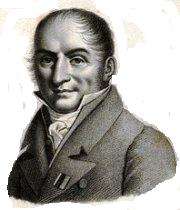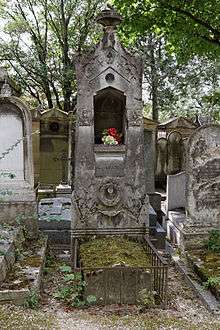Étienne Pariset
Étienne Pariset (5 August 1770, in Grand – 3 July 1847, in Paris) was a French physician and psychiatrist.

In 1805 he received medical doctorate in Paris with the thesis Dissertation sur les hémorrhagies utérines ("Dissertation on uterine hemorrhages").[1] In 1814 he joined Bicêtre Hospital as a physician, where in 1819 he was named head of department for mental illness. In 1822 he was appointed perpetual secretary at the Académie Nationale de Médecine, a position he maintained up until his death. From January 1826, he was associated with the Salpêtrière Hospital, where he succeeded Jean-Étienne Dominique Esquirol as physician for the insane.[2][3]
In 1819–22 he distinguished himself in his work combatting yellow fever in Spain, and from 1828 onward, conducted research of infectious diseases in Syria and Egypt. In the latter country, he became good friends with archaeologist Jean-François Champollion.[2][3]

In 1819 he became part of the Commission pour l'amélioration du sort des aliénés (Commission for improving the lot of the insane), whose members included Esquirol, Philippe Pinel and Antoine-Athanase Royer-Collard. In 1845 he was a founding member of the Société Protectrice des Animaux (SPA), serving as its first president up until his death in 1847.[2][3][4]
Selected works
- Observations sur la fièvre jaune faites à Cadix en 1819, 1820 – Observations on yellow fever, made in Cádiz, in 1819.
- Histoire médicale de la fièvre jaune observée en Espagne et particulièrement en Catalogne dans l'année 1821, 1823 – Medical history of yellow fever seen in Spain and particularly in Catalonia in 1821.
- Mémoire sur les causes de la peste et sur les moyens de la détruire, 1831 – On the causes of the plague, and how to destroy it.
- Histoire des membres de l'Académie royale de médecine; ou, Recueil des éloges lus dans les séances publiques, 1845 – History on members of the Royal Academy of Medicine.[5]
References
- Dissertation sur les hémorrhagies utérines Notice bibliographique
- PARISET Etienne (1770-1847) Amies et Passionés du Père-Lachaise
- Etienne Pariset Histoire de la psychiatrie en France
- Etienne Pariset (1770-1847) Medecin des Alienes, etc. (biography)
- Most widely held works about Etienne Pariset WorldCat Identities